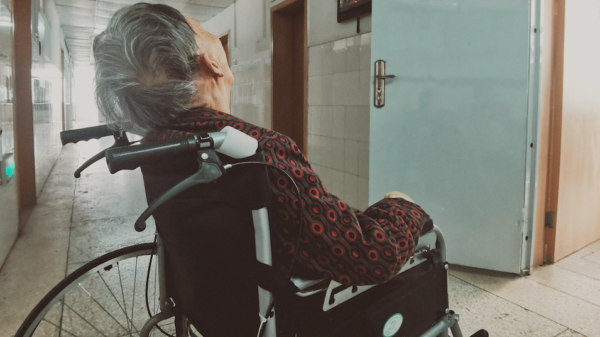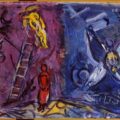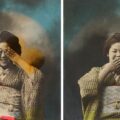Loosening the Flesh & the Mind: Relic & The Taking of Deborah Logan

Seven years ago, my maternal grandmother received a diagnosis of stage 4 lung cancer. Over the course of a few months her body and hair, both once golden and full of life, dulled to a pasty white and the cancer combined with the morphine that she was fed daily for pain to cause symptoms like dementia: memory loss, auditory delusions, and hallucinations. I once watched her lean forward to read a piece of paper that she swore had slipped from my lap; it was never there.
Just about a year after her death, my paternal grandmother moved into an independent care complex—then into an assisted living facility—because of her worsening dementia. Her symptoms were more active than those artificially-generated ones my late grandmother had faced. She experienced rapid mood and personality shifts. She was also a wanderer, and on more than a few occasions we’d find her in my late grandfather’s basement wood shop, having full blown conversations with his ghost.
As an avid horror viewer, I have experienced my fair share of terror. But nothing could prepare me for the fear that I felt as I watched the matriarchs of my own family wilt away in the fatal grips of age and cancer-related dementia. But watching horror movies is a kind of mastery. They allow us to face our real fears in the form of elaborate metaphors, come to life. This same fear of aging, mortality and, ultimately, the loss of self is poignantly illustrated in Adam Robitel’s found footage film The Taking of Deborah Logan (2014) and Natalie Erika James’ haunting tale, Relic (2020), two films that I have returned since my grandmother’s death
The traditional image of death within the horror genre takes on many shapes, bodies, and masks, but the formulaic situations that lead to the death of stereotypical and trope-ish characters remains the same: young adults with healthy, able bodies running for their lives, all doomed aside from one or two exceptional characters. . Often it is the literal past that comes to hunt them, as in Friday the 13th, Poltergeist, and A Nightmare on Elm Street. This is typical. This is the slasher genre in a nutshell. At other times the horror manifests a real social and/or physical transformation, as in Rosemary’s Baby (motherhood), Carrie (puberty), The Amityville Horror (divorce and remarriage).
In Natalie Erika James’s film Relic, three generations of women—grandmother (Edna), daughter (Kate) and granddaughter (Sam)—each grapple with a distinctly modern horror: a hereditary disease and, perhaps more importantly, the popularity of at-home DNA testing kits. Relic’s Edna exhibits quite a few, if not all of the most common dementia symptoms—memory loss, difficulty communicating, confusion/disorientation, personality changes, anxiety/depression, inappropriate behavior, paranoia, agitation, and hallucinations. What distinguishes her case is the inky black mold that begins to spread down the walls of her house and on her body.
What her daughter Kate brushes off as bruising from her mother’s mysterious three night disappearance in the woods, turns out to be much more sinister. It is as if her body and the house have become one; the rotting of Edna’s body is mirrored in the deprecation of the home. Bedrooms are filled with boxes of hoarded paperwork and memorabilia; an inescapable layer of dust and decay covers the surfaces of countertops, banisters and bedcovers and upon further investigation, Sam finds a series of crowded hallways leading to locked rooms in the back of her grandmother’s closet. Their labyrinthine twists and changing spatial quality mimic the claustrophobia and disorientation of Edna’s mind. Sam finds herself lost, without a cell signal (essentially a lack of all communication) and in a state of wandering panic for hours—literally trapped within the dementia.
After being chased through the walls of the house by a demon-like version of Edna, Kate, and Sam finally make it out into the safety of the surrounding woods. But as Kate stares at the stained glass window of the front door (a relic of her great grandfather who also died of Alzheimer’s) and listens to her own mother moan within the confines of her childhood home, she is just as quickly lured back in, not as an obligation, but as the physical and emotional support that her mother has needed since the start of the film. Fearful, yes, of the potential evil lurking on the living room floor, but Kate gently draws her mother to her and lifts her up, as if she weighs nothing at all. Moments later, Sam enters to find her mother and grandmother sitting at the foot of Edna’s bed. Kate peels back layers of molding skin and hair from her mother’s delicate frame.
At this moment, Edna is a colorless, sooty small thing. She is half her original size and as Kate lays beside her in bed, Sam lays behind Kate and they listen to Edna’s deep, belabored breathing. There is a final sigh of relief. Then Sam notices a spot of black mold on the back of her mother’s shoulder.
The almost cliff-hanger ending of Relic at first sent shivers down my spine. Will Kate chase her own daughter through the walls of their home, bloodied and helpless and monster-like? Will Sam know that she must stay and fight the beast that was once her mother?
In contrast to Edna’s parasitic infestation of dementia mold, Adam Robitel’s titular character, Deborah Logan, becomes literally possessed by the demon that is Alzheimer’s disease. Deborah’s symptoms are similar to the Edna’s in Ritual: wandering, insomnia, frustration, and even violence against others and herself. But the true connection between the films is the insight that the afflicted are not the only ones who experience horror.
According to a 2021 research survey by the Alzheimer’s Association, one-third of seniors will die with Alzheimer’s disease or another form of dementia, killing more people than breast and prostate cancers combined. There is no Candyman here. No masked killer with a machete. No Boogeyman waiting in the closet or under your bed to reach out and take you into the darkness forever. The darkness is something that comes on at first gradually, then all at once.
In the case of Deborah Logan and her caregiving adult daughter, Sarah, they are at the mercy of Deborah’s late stage Alzheimer’s brain that requires around the clock assistance. Though a documentary team staying with the Logans is able to catch many of Deborah’s “typical” symptoms on camera: loss of awareness, change in physical abilities and difficulty in communicating, they also tape her more unusual behaviors: levitation, extreme hyperactivity and in the end, the abduction and close-call cannibalizing of a child.
Sarah meanwhile spirals down into an alcohol-induced depression. Drinking becomes her way to relieve the extreme stress of taking care of her fading mother. To shut herself off from her mother’s hurtful comments, she becomes a mere shadow of herself. Sarah grieves the loss of her mother just as Kate grieves Edna in Relic, dramatizing stages of grief: denial, anger, guilt, and sadness. The final stage however, comes at a price. Sarah is forced to confront the damage her mother has caused, and the damage her possession creates. She chases her mother from home to hospital to abandoned cave, dodging mutilated bodies along the way. This journey is no longer Deborah’s but rather her daughter’s; the mission is to exorcize the demon squatting in her body and the key is acceptance.
The horror genre typically targets younger audiences. Teenagers and young adults pack into theaters to watch characters who look like them run, scream and attempt to fight against an un-killable killer. The excitement of identifying with the final girl, of warning those college kids not to check the eerie sound in the basement, these fears are met head on with buttery popcorn and smiling faces.
Now, with the rise of at-home DNA tests, extended multi-family living situations, and an oncoming senior care crisis, we see a new awareness among younger people of the trials of aging. As I watch my grandparents forget and transform while simultaneously feeling those first achy twinges of my thirties, films like Relic and the Taking of Deborah Logan weigh just a bit heavier. Am I nervous about my parents’ decline? Or about the burden of my own altered mind? What horror lies ahead, and within?
About Jacqueline Morrill
Jacqueline Morrill graduated with an MFA from Sarah Lawrence College. She currently teaches writing and horror theory at Worcester State University and Clark University.





